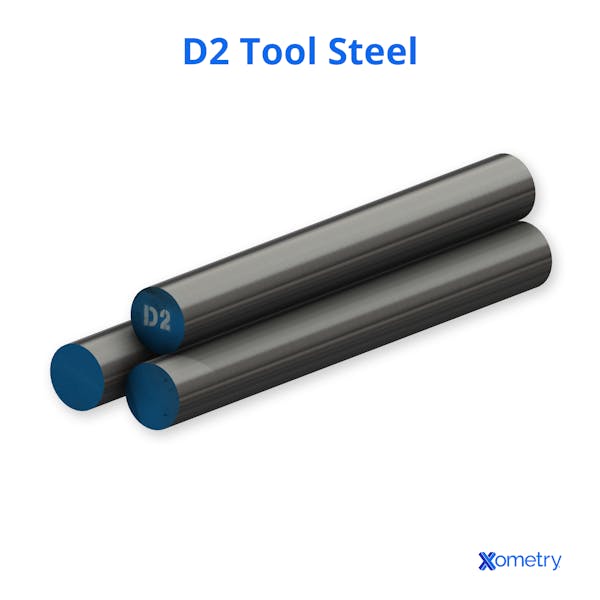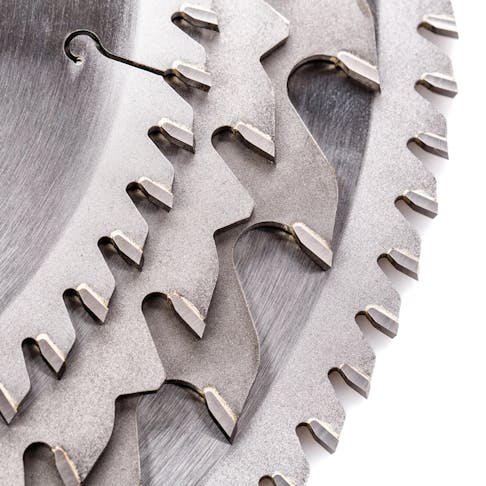D2 tool steel is renowned for its hardness, which is exploited by cutting applications, including cutting tools, knives, and dies. D2 is hard due to its mix of high carbon and chromium content, which also affords it favorable corrosion resistance properties.
This article discusses the uses, composition, and properties of D2 metal and how it compares to other steels.
What Is D2 Tool Steel?
D2 tool steel is a steel specially designed for use in tooling. D2 steel differs from other steels as it has high carbon and high chromium content. This composition gives D2 tool steel strong resistance against wear and abrasion. The “D” in “D2” indicates that it belongs to the D-series of tool steels, which are a cold work class of tool steels with a high carbon-chromium content. This steel can be hardened using heat treatment and is also machinable when annealed. D2 steel’s high chromium content also gives it good corrosion resistance. It is also designated with other names, such as 1.2379 in Germany and SKD11 in Japan.

How Is D2 Tool Steel Made?
D2 tool steel is made using an electric arc furnace (EAF). The furnace is used to melt the swarf from other machining processes, as well as other scrap steels. Additives are used to adjust the steel composition. After the steel is melted, it is either continuously cast into billets or cast into ingots, depending on the desired final product form. The use of the EAF is preferred because it is the most cost-effective method for melting large amounts of scrap steel. Following the initial melting and casting process, D2 tool steel may undergo further processing, such as forging, hot rolling, or cold working, depending on the desired shape and properties. Finally, the steel is heat-treated to achieve the required hardness and toughness, typically involving quenching and tempering. If needed, D2 steel can also be annealed to soften it for subsequent machining.
How Does D2 Tool Steel Differ From Stainless Steel?
D2 steel and stainless steel are both corrosion-resistant due to the presence of a high amount of chromium. However, D2 contains approximately 12% chromium, whereas stainless steel may have between 10-20%, depending on the grade. This gives stainless steel better corrosion resistance and D2 better wear resistance and hardness properties.
To learn more, see our guide on Stainless Steel Material Properties.
What Are the Uses of D2 Tool Steel?
D2 tool steel is so hard that it is able to cut through other steels. This allows it to be used in applications, including die punches and knives. D2 is also used to make:
- Saw blades
- Hand tools
- Tire shredders
- Forming rolls
- Punches
- Shears
- Drill bits
- Abrasion-resistant 3D printer nozzles
Is D2 Tool Steel Good for Knives?
Yes, D2 tool steel is good for knives. This is because of its high hardness and wear resistance, which allows it to stay sharper for longer. This is especially important for knives used in bushcraft, during which regular sharpening may not be possible.
What Is the Chemical Composition of D2 Tool Steel?
D2 tool steel is composed of iron and carbon with a high alloying content of chromium. D2 steel has an iron content of approximately 82%, a chromium content of 12%, and a carbon content of 1.55%. All alloying elements are listed in Table 1 below:
| Element | Percentage |
|---|---|
Element Iron | Percentage 82.57% |
Element Chromium | Percentage 12% |
Element Carbon | Percentage 1.55% |
Element Cobalt | Percentage 1% |
Element Vanadium | Percentage 0.90% |
Element Molybdenum | Percentage 0.80% |
Element Manganese | Percentage 0.60% |
Element Nickel | Percentage 0.30% |
Element Copper | Percentage 0.25% |
Element Sulfur | Percentage 0.03% |
What Is the Carbon Content of D2 Tool Steel?
The carbon content of D2 tool steel is in the range of 1.5% to 1.6%. This is considered a high amount of carbon. The high levels of carbon in D2 give it a high tensile strength and hardness.
What Are the Properties of D2 Tool Steel?
Table 2 shows the properties of D2 tool steel:
| Property | Value |
|---|---|
Property Density | Value 7,700 kg/mz^3 |
Property Yield strength | Value 1,300 MPa |
Property Hardness | Value 62 (Rockwell C) |
Property Magnetism | Value Curie point of 767 ºC |
What Is the Machinability Rating of D2 Tool Steel?
D2 steel has a machinability rating of 27%, when compared to AISI 1112 steel (a standard for machinability). This is very poor compared to other steels. It is a result of having a high carbon and chromium content. However, this is common for steel tools, which commonly have a machinability rating between 20–30%. This is good because it also means that the steel can be used for machining other steels.
What Are the Characteristics of D2 Tool Steel?
D2 is known and used for its high hardness of 62 (Rockwell C). However, there are many other characteristics to consider when deciding if D2 steel is suitable for an application.
D2 steel also has:
- Moderate corrosion resistance
- High tensile strength
- Good wear resistance
- Poor machinability
- High density
- Deep hardness
Is D2 Tool Steel Rust-Proof?
No, D2 steel is not rust-proof, however, it is moderately corrosion-resistant. D2 has a high chromium content similar to stainless steel, which gives the material moderate corrosion resistance. D2 steel is sometimes known as a “semi-stainless” steel. The corrosion resistance of D2 steel can be increased by machining a polished surface finish.
Can D2 Tool Steel Be Welded?
Yes, D2 tool steel can be welded, but with difficulty. D2 tool steel is not well-suited to welding due to its high carbon content, which puts the welding at risk of cracking and embrittlement in the heat-affected zone (HAZ). D2 steel must be in the annealed condition before welding. During welding, the D2 steel will need to be preheated and held at a temperature of between 370ºC to 540ºC
Can D2 Tool Steel Be Forged?
Yes, D2 steel can be forged in a very similar manner to high-speed steels. Forging of D2 steel must be done between 954ºC and 1,065ºC. The best process for forging small amounts of D2 steel is to heat it and then slowly cool it in lime or another suitable insulating medium. Larger pieces can be heated in a furnace and then left to cool slowly in the same furnace to maintain temperature consistency.
What Are the Thermal Properties of D2 Tool Steel?
Table 3 below shows the thermal properties of D2 tool steel:
| Thermal Property | Value |
|---|---|
Thermal Property Melting point | Value 771 ºC |
Thermal Property Thermal conductivity (At 20 ºC) | Value 20 W/m-K |
Thermal Property Thermal expansion (From 20–100 ºC) | Value 10.494 x 10-6 cm/cm-ºC |
What Are the Common Forms of D2 Tool Steel Material?
D2 tool steel is available in a range of forms, which are discussed below:
- Sheet: Sheets of D2 tool steel can be supplied in cold-worked or hot-worked conditions, with thicknesses ranging between 0.5 mm and 6 mm.
- Bar: D2 tool steel can be supplied in round bars from 10–250 mm (and higher) in diameter in circular or tubular cross-section.
- Plate: Plates of D2 tool steel are similar to sheets of D2 steel but are always thicker.
- Annealed: D2 tool steel is usually delivered in an annealed condition as it is the easiest condition to machine. The hardness of annealed D2 may vary on the rate of heating and cooling but is approximately 220 Brinell hardness. D2 is annealed by slowly heating to above 900ºC and then cooling in the furnace to room temperature. The process is then repeated again, but this time allowing the steel to remain in the heat for three to four hours before cooling.
- Cold worked: D2 tool steel is one of a series of cold-work tool steels. The series of cold-drawn steels (also referred to as cold-work steel) is air-hardened. This means D2 is slowly heated to 750–780ºC and maintained at this temperature before being air-cooled. D2 is very sensitive to temperature and must not be overheated.
What Are the Equivalents of D2 Tool Steel?
Table 4 below lists some equivalents of D2 tool steel:
| Country | Equivalent |
|---|---|
Country UK | Equivalent BD2 |
Country USA | Equivalent D2 |
Country Germany | Equivalent 1.2379 |
Country France | Equivalent Z160CDV12 |
Country Japan | Equivalent SKD11 |
Country Russia | Equivalent Ch12D1 |
Country Spain | Equivalent F5211 |
What Are the Disadvantages of Using D2 Tool Steel?
The biggest disadvantage of using D2 tool steel is that it is not very resistant to corrosion compared to stainless steel. D2 tool steel has:
- Poor welding capabilities
- High price due to alloying elements
- Difficult to machine during manufacturing
Is D2 Tool Steel Expensive?
Yes, D2 tool steel is expensive due to the high percentage of alloying elements in its composition. D2 steel price varies but is approximately $11 per kg (prices may fluctuate based on market conditions and specific suppliers).
Is D2 Tool Steel Better Than H13 Tool Steel?
D2 tool steel is certainly better than H13 tool steel in terms of hardness. H13 only reaches a Rockwell C hardness of between 38 and 48, whereas D2 reaches 61. However, H13 is used in hot operating conditions as it retains its hardness at higher temperatures. The decision on which is better overall depends on the intended application.
What Is the Difference Between D2 Tool Steel and M2 Tool Steel?
D2 is classed as a cold-work steel, whereas M2 is a high-speed steel. Both are equal in hardness. However, they differ as M2 tool steel has a finer grain boundary, which allows it to retain an edge better than D2. The advantage of using D2 over M2 is that it has better corrosion resistance properties.
Summary
This article presented D2 tool steel, explained it, and discussed its composition and properties. To learn more about D2 tool steel, contact a Xometry representative.
Xometry provides a wide range of manufacturing capabilities and other value-added services for all of your prototyping and production needs. Visit our website to learn more or to request a free, no-obligation quote.
Disclaimer
The content appearing on this webpage is for informational purposes only. Xometry makes no representation or warranty of any kind, be it expressed or implied, as to the accuracy, completeness, or validity of the information. Any performance parameters, geometric tolerances, specific design features, quality and types of materials, or processes should not be inferred to represent what will be delivered by third-party suppliers or manufacturers through Xometry’s network. Buyers seeking quotes for parts are responsible for defining the specific requirements for those parts. Please refer to our terms and conditions for more information.


